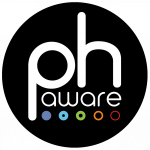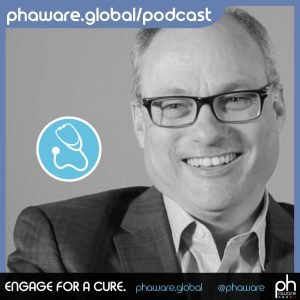Phaware Podcast: Dunbar Ivy, MD: Pediatric Pulmonary Hypertension Expert

This podcast series, created and produced by phaware, is being offered as a regular guest feature on Pulmonary Hypertension News to bring the voices and life experiences of PH patients, family members, caregivers, healthcare specialists and others to our readers. You may listen to the podcast directly, or read the transcript that runs below.
I’m Aware That I’m Rare: Dunbar Ivy, MD
The phaware™ interview
Dunbar Ivy, MD, is currently the Section Head of Pediatric Cardiology and the Director of the Pediatric Pulmonary Hypertension Program at the University of Colorado. He has published more than 100 medical articles, primarily focusing on pulmonary hypertension in children. He discusses the importance of Pediatric Pulmonary Hypertension Guidelines, the work of the Pediatric Pulmonary Hypertension Network (PPHNet.org) and how a PH Research app could change patient care.
I’m Dunbar Ivy. I currently live in Denver, Colorado. I’ve been there for 25 years. I moved there for my training in pediatrics, and then my boss, mentor, was interested in altitude medicine and pulmonary hypertension. He was a great guy, so I just became very interested in pulmonary hypertension. Ever since I was in training, I’ve been interested in it. The changes have been dramatic in terms of where we were in 1991 and where we are now.
then my boss, mentor, was interested in altitude medicine and pulmonary hypertension. He was a great guy, so I just became very interested in pulmonary hypertension. Ever since I was in training, I’ve been interested in it. The changes have been dramatic in terms of where we were in 1991 and where we are now.
The good news is that we have medicines that help patients, I think, that give them a better quality of life. I think they improve survival, but we don’t have a cure. Compared to 1991, 1992 where we had no approved drugs for anyone, so now, at least we have that.
If you look throughout adult medicine, things are very much based on evidence. There’s a lot more patients for many diseases, so you have a lot more opportunity to test things and grade them as to, “Do we have randomized placebo control trials? If that’s successful, then this drug gets approved.” Even if we don’t have evidence, there’s still plenty of patients who need help.
We need to have some guidelines that will help people to do the right thing. A guideline, people sometimes think that a guideline is a mandate, but it’s really not. It’s just saying, a group of interested experts got together, looked at all the information they could, made some recommendations, and that’s just to help the clinician to know “What should I be thinking? What should I be doing? What kind of tests should I do? When should I be on more aggressive therapy? What kind of patient would be okay to just be on a pill, which ones need more aggressive IV or SubQ or whatever.”
That’s really the goal of the [Pediatric PH] Guidelines. It’s not a mandate to say, “You have to do things this way.” But there was such a gap, such a huge need just for some basic information in terms of what kind of tests should you do, what order should you do them in. Once you get that information, what kind of medicines should you use? What do we know about those medicines in children? Also, to define these further gaps so that we can fill them in. The guidelines were … Initially, it was too big because it tried to combine a lot of very good science around the lung and lung vasculature and the heart and heart function in children and adults with pulmonary hypertension, plus the sort of clinical recommendations.
The American Heart Association, American Thoracic Society just said, “This is too big. This is too much.” You really have to pare it down to just some basic clinical information. That’s still massive work. For me, there are many challenges, hurdles that we have to get to before, even if a new drug is approved, so an important one is the formulation, because if it’s just in a pill that can’t be chewed or crushed up, then that’s going to be a challenge for very young kids, so the formulation is always a challenge to think about.
If it’s an inhaled medicine, a two-, three-, four-year-old is not going to be able to do six breathing treatments a day, for example, so that’s a challenge. The second one, and it’s equally as important, is the dose. Usually for adults, there’s maybe one or two doses, or maybe you increase the dose, but for a young child, we really don’t know for many things what is the appropriate dose, so we take guesses by saying if a drug is approved for a 70 kilo patient then for a 40 kilo patient, it might be half. And then half that and half that, but more and more the studies that are being done that are either in some of the clinical trials are doing so-called pharmacokinetics. You take the medicine and then with one or two blood draws, they can get an idea (if) “Are you getting close to the drug level that you need to?”
We’re still quite a ways away, but I think the formulation, the dosing, and then the question is: Are they effective or not? That’s a challenge because we don’t have a standard test yet to decide when would the FDA approve the drug, so if the FDA wants to approve a drug because it makes patients feel better, live longer, but how do you do that to compare a six-month-old versus a 16-year-old? That’s a real challenge. Right now we don’t have a standard test that the [U.S.] Food and Drug Administration will say, “Okay, if the patient does better, the child does better on this test, then we count that as efficacy. It works, so then we’ll consider approving it.”
The final one is the safety aspect because drugs are metabolized different, so there’s some pulmonary hypertension medications that are in pill form that we probably wouldn’t use in very young children, but if a child took it, it might be dangerous because of some of the metabolites or metabolism of the drug, so there’s a lot more than just saying, “Well, the biology sounds good. It’s approved in adults. Let’s rush to it.” It does take a little longer with other considerations.
The [Pediatric Pulmonary Hypertension] Network (www.PPHNet.org) is a collaborative group … Programs that are very interested in pulmonary hypertension that want to come together as a group and work together to help solve the problems, to help treat the patients better. It’s a rare disease, and so most programs don’t have huge numbers, so that by having 10 centers, even though there may be a few patients at each center combined, we might be able to look at more patients and say, “For that type of patient, let’s think about A, B, and C,” or we’re hoping to get to a point to say, “Well, if it’s that kind of patient, this is the drug we should start first.”
Part of it is certainly discussing clinical ideas. As a network, I’ve written some papers about diagnosis of pulmonary hypertension, treatment of pulmonary hypertension, and then the guidelines came along sort of as an effort of that group, plus some others. Right now we have no drugs that are approved for children for pulmonary hypertension. We, right now, don’t have a straightforward path as to how to get them approved because we don’t have a so-called end point that everybody can say, “If you meet this end point, then it’s effective. Then you can look at the other aspects, and then approve it.” We don’t have that. The six-minute-walk test that you use in adults really is not very reliable in children. Certainly children of different ages walk different paces and times, and also, it’s not reliable on a three-, four-year-old.
If we approve a drug, we want it approved for all children and not just for children of a certain age. The ability to have something that we can show to the Food and Drug Administration that we can show that patients feel better and do more, we’re very hopeful that this will take that final step to getting a path for approval of drugs in children. If we had approval then it really allows us to advocate for the patients better.
When we see a patient in the clinic, we usually see them about every three months, and then we go back and say, “Well, how are things going? How many flights of stairs can you walk up? Can you keep up with your friends?” That kind of thing. When we do that, it’s relying on their memory for the last three months. If we had something like a [Pediatric Research] app, then we’d have a much better picture of what their last three months were really like, rather than just a recollection of what the last three months were.
“Well, I forgot, I didn’t … Missed a week of school,” whereas if you had an app that they could use, then they could record that, so you’d have a better or a more complete picture of how someone was doing. Then if they were in trouble, they might have a “really not feeling well” … mechanism to push a button and have a text go to the pulmonary hypertension nurse, something like that. That would be really, really neat.
If we can do this and then lead to approval of some medications for children, it would just be fabulous.
EVERYBODY HAS A STORY. WHAT’S YOURS?
phaware wants to share your pulmonary hypertension story with their engaged global audience. Whether you are a patient, caregiver, or medical professional, they are enlisting PH community members from across the globe. Visit www.phaware.global/podcast to share your story and to be considered for a future episode.
Learn more about pulmonary hypertension at www.phaware.global. #phaware #phawarepod
Learn more about phaware’s PH Research app at www.phaware.global/walktalktrack

Note: Pulmonary Hypertension News is strictly a news and information website about the disease. It does not provide medical advice, diagnosis, or treatment. This content is not intended to be a substitute for professional medical advice, diagnosis, or treatment. Always seek the advice of your physician or other qualified health provider with any questions you may have regarding a medical condition. Never disregard professional medical advice or delay in seeking it because of something you have read on this website. The opinions expressed in this column are not those of Pulmonary Hypertension News or its parent company, Bionews Services, and are intended to spark discussion about issues pertaining to pulmonary hypertension.









Leave a comment
Fill in the required fields to post. Your email address will not be published.